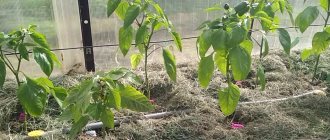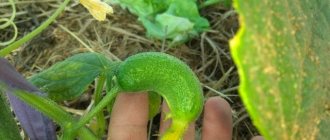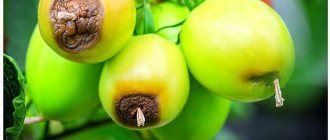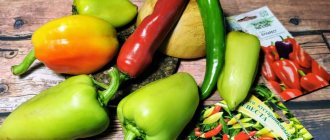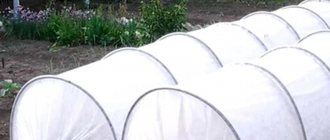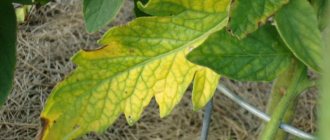Whatever you say, sweet red peppers and sweet green peppers are two very different things. But it often happens that peppers stubbornly refuse to turn red on the vine. Why don't peppers turn red? What is he missing? How to make him blush? You can, of course, try to shame the peppers in front of the entire greenhouse, and defiantly put those that grow in pots in the corner :))) But it is unlikely that the methods invented for unfortunate schoolchildren will work on peppers.
Gardeners have to use other cunning methods to encourage peppers to ripen and turn red. Let's talk about them. And also about the two ripenesses of peppers, about the varieties and their characteristics, and about the ripening of peppers at home.
Pepper ripening stages
Peppers can be picked long before they turn red; they are tasty even when unripe. Not only their taste, but also storage features and harvesting technology depend on the stage of maturity at which the fruits are picked.
There are two options for pepper maturity:
- Technical. It is also called harvest maturity. From the moment of formation of the ovaries to technical ripeness, 40-45 days pass. At this stage, the fruits have not yet acquired their full varietal properties, but are already quite ready both for consumption and for making winter preparations.
- Biological. It occurs during the period of seed ripening, and the fruits acquire bright varietal characteristics.
It takes 3-4 weeks from technical to biological ripeness. All this time, the fruits can be collected and eaten, canned, added to salads and all kinds of dishes. But it is during this last month that the vegetable accumulates a maximum of nutrients, sugars, and microelements.
Biologically ripe pepper differs from technically ripe fruits not only in appearance - color, but also in usefulness. Red peppers are healthier than unripe green peppers.
Low temperature
The optimal temperature is considered to be from +22°C to +25°C. At night it should not be below +15°C, otherwise the flowers will begin to fall off. And if the temperature drops below +12°C, then the plant stops growing altogether.
Drafts also have a detrimental effect on vegetables, and this must be taken into account when ventilating the greenhouse. But the pepper cannot tolerate too high a temperature (more than +40°C) and begins to wither, and already at temperatures above +32°C the fruits stop setting.
[custom_ads_shortcode2]
Why peppers don’t turn red: the main reasons
It happens that peppers, having become large, remain green for a long time - they do not turn red. There are several reasons why fruits do not ripen. The gardener’s task is to find out what exactly caused the slowdown in the redness of the pepper, and based on this, take appropriate measures.
Features of the variety
Often, gardeners try to get high-quality peppers from seeds obtained from store-bought vegetables. It is useful to know that most of the large and beautiful peppers were brought to Russian supermarkets from warm countries or from the south of Russia.
Why do peppers not turn red?
- Zoning. Vegetables grown somewhere in Egypt, Turkey or the Krasnodar Territory are not suitable for regions with a temperate climate. Varieties grown in warm climates do not have time to ripen in most regions of Russia. Or they ripen several weeks later than the released varieties.
- Varietal features. There are varieties of pepper that do not turn yellow or red even at the stage of biological maturity. As they ripen, they acquire a green color - light or dark, purple, chocolate. To avoid being misled, read the information about varietal characteristics indicated on the packaging in advance. “Non-reddening” varieties include, for example, Viking, Zephyr, and Green Miracle peppers. If you need red peppers, familiarize yourself with the characteristics of the variety in advance.
- Terms of ripening. There are varieties that ripen several weeks later than others. Find out in advance which category the pepper belongs to - early ripening, mid ripening or late. The range of ripening times is very large - some varieties ripen in 90 days, others in 150 days.
Unfavourable conditions
Pepper “refuses” to turn red if it finds itself in unfavorable conditions - agricultural practices are violated, the weather is bad.
Circumstances under which peppers do not turn red:
- Temperature. Pepper grows and ripens well at +18...+30°C. The fruits do not ripen if the weather is cool - when the thermometer drops to +12...+13°C. A heat-loving crop simply stops growing at such temperatures. If the temperature rises above +35°C, the pepper bushes dry out quickly.
- Lighting. Pepper grows provided that it is illuminated for at least 12 hours during the day. If the daylight hours are too long—more than 14 hours—the ripening of fruits may also be disrupted.
- Watering. Peppers have problems with growth, ripening and fruiting if they are watered with cold, unsettled water. Also, the method of watering affects the development of pepper - water should not be allowed to get on the foliage and stems; it is poured only at the root.
- Thickened plantings. If the pepper bushes are planted too densely and block each other's light, the fruits are not in a hurry to ripen, they do not turn red, as they do not have enough nutrition.
Errors in agricultural technology
Errors in agricultural technology, which are often made by inexperienced gardeners, can also lead to delayed ripening.
Agrotechnical errors due to which peppers do not ripen:
- Incorrect planting of seeds. Sowing in the ground can be carried out only after temperature fluctuations have stopped, the soil has warmed up and stable heat has been established.
- Unsuitable soil. Pepper needs light, fertile soils; heavy clay soils and overly acidic soils are not suitable for it. To prevent the pepper from slowing down in ripening, organic matter and dolomite flour are added to the beds, which deoxidizes the soil.
- Fertilizers were applied incorrectly. Pepper reacts negatively to excess nitrogen fertilizers. Plants, instead of directing their energy to ripening fruits, build up green mass. Nitrogen is added before the beginning of summer; it is contraindicated during flowering and fruiting. A lack of potassium also has a negative effect on the ripening of fruits; if it is deficient, peppers may not ripen at all. A similar situation is usually observed on soils that contain a lot of sand and peat. Calcium deficiency is also dangerous, which can be combated with wood ash.
- Excess of ovaries. Their abundance negatively affects the yield and can cause a delay in the ripening of peppers - they do not have time to either reach a large size or turn red.
Thinning the ovaries helps to avoid the problem. It is recommended to cut off the first inflorescence located at the branching point of the stems. Only one bud, the most powerful one, should remain in the internode. Otherwise, the bush will not have enough energy to ripen all the fruits. - Root damage. This situation can occur with the seedling growing method. If the roots are damaged when transplanting seedlings, this can have an extremely negative impact on the entire subsequent growing season of the plant. Peppers with damaged roots take a very long time to recover, the bush will lag behind in development, and the fruits will not have time to ripen. Careful picking and replanting of pepper seedlings helps prevent the problem. It is carried out exclusively by the transshipment method - the seedlings are removed from the planting container and moved to a new place along with a lump of soil. It is advisable not to touch the roots at all during transplantation.
Nutrient deficiencies
Clay soil is not suitable for pepper; this vegetable loves light soil. It should be structured and enriched with vermicompost. Also, it should not contain too much nitrogen: it increases the amount of foliage, which affects the yield.
It is recommended to fertilize every 2 weeks. It is desirable that these are both organic and mineral fertilizers. During fruit set, phosphorus fertilizers are needed. And to prevent rotting of peppers, it is necessary to apply fertilizer with calcium - for example, calcium nitrate - 2-3 times during the growing season.
Important! Regardless of the stage of development, peppers require potassium. Feeding with wood ash will help replenish this element.
[custom_ads_shortcode2]
How to speed up the ripening of peppers on a bush?
The goal of any gardener growing peppers is to get large, fleshy and brightly colored fruits. Having reached biological ripeness, peppers become incredibly tasty, go well with other vegetables and meat, and are ideal for processing and preservation.
General methods
It is not always possible to reliably, with 100% accuracy, determine the cause of delayed maturation. If the weather is good and there are no problems with the variety, then you need to take measures that will encourage the bushes to accelerate the ripening of fruits.
What to do to make peppers turn red faster:
- if it’s autumn and it’s getting cool, cover the beds with ripening peppers with agrofibre or non-woven material;
- water the pepper only with warm water, heated to +60°C, pour it exclusively into the root zone;
- spray the bushes with phosphorus-potassium fertilizers - for example, potassium sulfate (1 teaspoon per 10 liters of water) or a solution of wood ash (300 g per 10 liters of water);
- tear off some of the leaves - they delay the ripening of the fruit, but do not overdo it, tear off the tops and bottom leaves;
- if there are autumn rains, protect the pepper from excess moisture by constructing a film shelter;
- add yeast solution (200 g live or 10 g dry per 10 liters of water).
Hot peppers, unlike bell peppers (sweet ones), do not ripen after they are picked from the bush. To make the hot pepper pods turn red, the bushes are dug up and hung with the tops down.
Nuances for closed ground
Pepper is a heat-loving crop, therefore, to prevent the ripening of fruits from slowing down, in greenhouses it is necessary to close all the windows and the entrance door at night. This will protect the bushes from freezing and drafts.
How else to speed up the ripening of peppers in a greenhouse:
- install and turn on additional heaters;
- place plastic bottles filled with hot water between the beds;
- cut off too long shoots during active growth - this will improve the lighting of the bushes and stimulate the ripening of peppers;
- add light by installing ultraviolet lamps - blue light is beneficial for peppers even if there is enough sun in the greenhouse.
Weakened pepper bushes that are unhealthy in appearance are not recommended to be pinched and pinched - they may die from this procedure.
Nuances for open ground
The lack of cover makes it difficult to grow peppers heading into fall. If ripening is delayed, and it is already cold outside, you will have to provide the bushes with heating - bottles or stones heated in the oven are placed between the beds, as in a greenhouse.
In order for the peppers to turn red in time, it is important to regularly form bushes. At the end of August, all flowers are picked off and shoots that are too lush are removed. With the arrival of autumn, all the small peppers are picked - they still will not have time to ripen, but will prevent the ripening of large fruits.
Nuances for greenhouses
Since pepper is a heat-loving crop, it is recommended to close the windows and doors in the greenhouse at night. This will prevent freezing and protect against drafts. For additional heating, you can install heaters or place plastic bottles of hot water between the beds.
Long shoots during the active growing season need to be pruned in a timely manner to improve illumination and stimulate reddening of the fruits.
Important! Unhealthy or weakened-looking bushes should not be pinched or pinched, otherwise the plant will completely die.
Light is added to the greenhouse using ultraviolet lamps. Even if there is enough sunlight, the blue spectrum will not be superfluous for peppers.
Is it possible to ripen peppers at home?
Bell peppers can be ripened in much the same way as fruits. To ensure that the fruits reach biological maturity and do not deteriorate, turn red or lose their taste, they are placed in a warm and dark place for 4-5 days.
How to ripen peppers:
- First way. Place the peppers in a dark room, such as a pantry, and place one red pepper or ripe apple between them.
- Second way. Place food foil on the windowsill. Better on the north window. Place unripe peppers on foil. They will be exposed to sunlight reflected from the foil, this will stimulate the ripening process.
- Third way. If the harvest is large, place the peppers in paper bags or cardboard boxes. Place bananas and apples nearby. Close the container tightly; after a few days the pepper will turn red.
If there is no task to make the pepper red immediately, it is placed in a cooler room.
Optimal conditions for storing pepper:
- temperature - +10...+12°C;
- air humidity - 85–90%.
Under these conditions, the pepper will be stored and ripened at the same time. Biological ripeness - complete redness, the fruits will be reached in about a month.
A large number of ovaries
To prevent the bush from forming too many ovaries, you need to remove the flower that appears first at the branching point of the branches. It is also called crown. Sometimes there are several crown buds. All of them must be removed, otherwise the plant will not branch well and will spend a lot of energy on these buds. One of the strongest buds should be left at the nodes. You should also not leave all the ovaries on the bush: they will only slow down each other’s development. The normal amount for a tall plant is from 17 to 25 ovaries.
[custom_ads_shortcode3]
There are no green peppers - true or myth?
In markets and stores you can see green, yellow and red bell peppers. Many people think that the fruits offered belong to different varieties. In fact, these peppers may belong to the same varieties, they are simply picked at different stages of ripening.
Green, yellow, orange fruits are unripe red peppers. But there really are varieties in the world that, even when ripe, remain yellow or orange. Green peppers are an intermediate stage of red, orange or yellow varieties.
The color of pepper affects not only the taste of the fruit, but also the nutritional content:
- Green pepper. It contains more phytosterols, which regulate fat metabolism and remove cholesterol from the body, and vitamin K, which prevents atherosclerosis.
- Yellow and orange peppers. They contain a lot of carotene and vitamin C. They are superior to red and green peppers in terms of potassium and iron content, therefore they are useful for people suffering from anemia and cardiovascular diseases.
- Red pepper. It has a lot of sugar, so it tastes sweeter than other peppers. It contains a valuable substance - lycopene, which is recommended for the prevention of cancer. Red pepper contains more vitamins A, C, B, E.
Poor watering
Plants require regular, but not too much watering (about 3-4 l/m²), preferably in the morning. During fruiting, the volume of water should increase. Lack of irrigation will affect the fruits: cracks may appear. It is also recommended to mulch the soil, since the root system of peppers is very delicate and loosening can damage it. Straw, grass clippings, sawdust, and sunflower husks can be used as mulch. This layer should be about 5-7 cm and updated once a month. It protects the soil well from overheating and hypothermia, as well as from moisture loss.
Learn how to properly water peppers in a greenhouse
[custom_ads_shortcode3]
Advice from experienced gardeners
Along with the basic rules for accelerating the ripening of peppers in open and closed ground, there are a number of simple measures that can speed up the ripening of peppers.
Useful tips from experienced gardeners:
- In order for the peppers to ripen faster, you need to harvest more often. This is especially important at the beginning of fruiting - it is necessary to pick the first peppers, then the next copies will ripen faster.
- Banana peels placed on the beds help stimulate ripening. It releases ethylene, which accelerates the ripening of vegetables and fruits.
- If the gardening season is drawing to a close and temperatures are dropping, only the largest peppers should be left on the bush and the small ones should be picked off. Also, all flowers and ovaries must be removed from the bushes, then all the energy of the bushes will be directed to ripening the remaining peppers.
Delayed pepper ripening is a minor problem that has many solutions at different stages of the growing season. If you do not violate agricultural practices, the peppers will definitely reach their biological ripeness. As a last resort, if the weather does not allow waiting, the fruits can be ripened at home.
0
0
Copy link
For open ground
In open areas, it is more difficult to protect the crop from hypothermia, so it requires shelter and heating similar to a greenhouse (bottles between the beds or stones heated in the oven).
A prerequisite for rapid maturation is regular shaping . At the end of the summer period, all flowers are removed, and shoots that grow too large are plucked during the entire growing season.
Small peppercorns are also removed from the bush at the beginning of autumn, as they will no longer be able to reach biological maturity. The remaining fruits can be removed from the bush unripe in the event of early cold weather and constant rainy weather. In conditions of increased dampness and coolness, the fruits quickly rot.
Harvesting and storage
The fruits are harvested by cutting them with pruning shears or a knife along with the stalk. It is important to know that by harvesting pepper fruits while they are still green, that is, at the stage of technical ripeness, you can get a much larger harvest than if you harvest ripe fruits (red, yellow, orange). It takes about 2.5-3 more weeks until full ripening, and during this time new fruits will develop.
Many varieties and hybrids of pepper are stored in the vegetable section of the refrigerator at a temperature of 2-3 ° C for a month without loss of taste. Peppers are well preserved if left on the stem. To do this, select plants with a large number of fruits, pull them out of the ground by the roots and hang them in a room with a temperature not lower than 0 ° C.
To make the pepper turn red faster. Some tricks for making peppers turn red faster
You should put a couple of red fruits in the boxes with folded and unripe sweet peppers. It could be a couple of tomatoes, red apples or the same, but only red peppers. The top is covered tightly with newspaper.
The ruddy sides of the peppers will begin to appear after just one week. The accumulated ethylene in scarlet fruits will spread throughout all vegetables and promotes rapid ripening. It is very important that the vegetables lie in bulk all together. If each of them is wrapped separately in newspaper, nothing will happen. The best stimulants for ripening are red apples, so they are not recommended to be placed next to already ripe vegetables. Such proximity will lead to rapid overripening and rotting.
Some summer residents have adapted, and the picked unripe peppercorns are placed on food foil. The foil is then placed on the eastern or western window sills. The sun will be pushed away from the foil, this promotes rapid ripening.
You can artificially stop the development of the bush and stimulate ripening. At a height of 3-4 cm from the ground, use a sharp knife to punch a through hole and insert a sliver of wood into it. The bush will stop growing, the peppers will ripen sooner.
Therefore, bushes of burning varieties are kept in the garden, covered and wrapped at night so that they do not freeze. If climatic conditions no longer allow keeping the plant in open ground, you need to carefully transplant it into a pot and take it indoors. Those crops that are cultivated in greenhouses must be provided with the correct temperature and lighting.
How does burning in the mouth and tongue manifest?
The symptom is clearly noticeable, may occur sporadically and disappear on its own. This happens when taking bitter medicines or eating spicy foods (“fire” in the mouth). A slight irritation of the mucous membrane may bother you after dental procedures; this is quite normal.
True diseases can be assumed if:
- Dryness and burning in the mouth often appear in certain areas of the oral cavity
- Unpleasant sensations intensify and are accompanied by numbness
- The tingling becomes constant
In most patients, the burning sensation manifests itself in the morning, intensifies during the daytime and subsides towards night.

